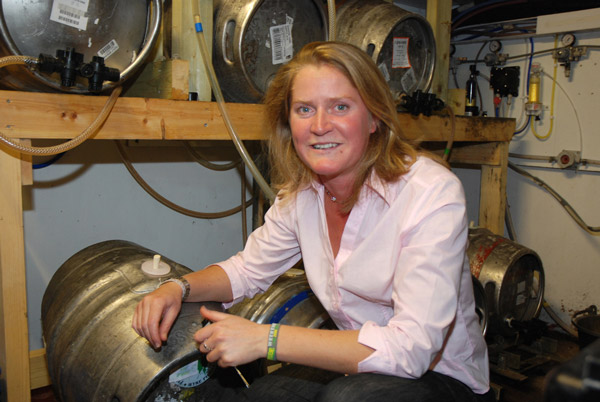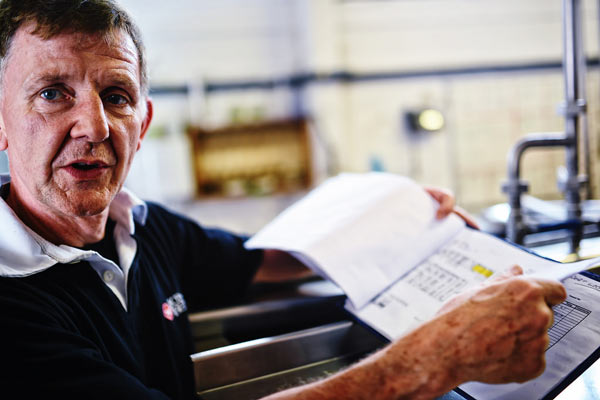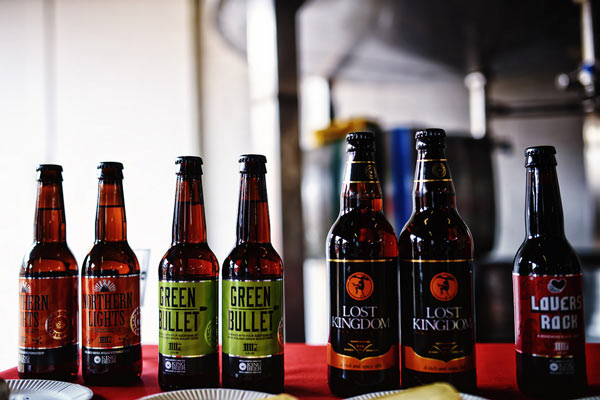Unless you live under a rock that has no beer in it whatsoever, you’ve probably noticed the ever increasing popularity of homebrewing (maybe) and craft beer (definitely).
Of course, homebrewing is nothing new – make your own beer on the cheap? Yes please! People have been at it for years – I have memories of my granddad creating a small explosion of alcoholic sludge in the boiler room many years ago in a homebrewing attempt gone hilariously wrong.
So yes, it can go wrong, and it can also go right – with the right guidance.
Enter our two experts, Belinda and Ian – here to provide said guidance.
Meet The Experts


J: In a nutshell – what does someone need to get started as a homebrewer? Is it easy? Hard? Should they spend much? What’s the bare minimum, and what can different sorts of budgets get you? [NB i’m not sure what different budgets entail so feel free to suggest a few ranges here?]
I: First off get yourself a good homebrewing book – there’s many on the market Amazon has loads to choose from. From reading the book and recipes you could budget about £50.00 – £100.00 towards a basic kit and ingredients
B: You don’t have to spend much, if anything initially. You can use your cooker or a Burco water boiler to boil your wort and add hops, you would also need a fermenting bucket and a mash vessel with a slatted bottom, to collect the wort, and a cool box – setting up can cost around £30!
I wouldn’t suggest spending too much to start, play around with the basics, and as you develop your techniques, you will realise what further equipment you need such as cooling equipment, plate heat exchangers, pipework and extra tank space.
On a larger scale, I helped set up my village pub with a micro brewery of 100 litres, this cost them £570 for the brewery, so it can be very cheap.
Suppose I want to get started – how DO I get started in homebrewing – could you outline it in a nutshell?
B: You will definitely need:
- A mash vessel; this is essentially a container that is insulated, with a slatted bottom, or a kind of sieve / bag, a basic cool box works well for this
- A boiler / Burco boilers to boil the wort and add the hops
- A thermometer; as monitoring and controlling temperature is very important, especially in the mashing process.
Cooling the brew down is the trickiest part of the brewing process and there are all sorts of ways to do this. From putting it into a bucket of ice, being patient and waiting for it (detrimental to quality) to inserting a cooling coil. Winter is the best time to brew, as the mains water is cooler and you can use this together with the outdoor temperatures to cool the wort.
Once you have created your first home-brew and got a taste for it, more adventurous home-brewers can use grain, which will give the freedom to develop your own recipes, and create more diverse styles.
What are the kinds of drinks you can brew at home? Is there anything that it’s only possible to brew with full commercial equipment? And something that it’s only really best to do at home?
I: You can home brew anything really from beer – of all styles, wine, cider. You can homebrew spirits as well….
Things that are best at home are when you start using expensive ingredients that will be affordable in small batch brews but not commercially – IE you could put saffron into a brew which would be amazing but would not be commercially viable due to the high costs involved.
B: Lagers require a critical lower temperature control at fermenting (around 13°C), which can be difficult to control at home with basic equipment and no cooling. However, ale yeast requires higher temperatures, usually about 20°C, which is close to room temperature and easier to maintain at home.
In a nutshell, what’s the difference between a homebrewer and a commercial brewery?
B: The main difference between commercial and home brews is the consistency of quality and flavour, a commercial brewery will be able to produce a large volume of beer with consistent flavours in every batch and this is largely down to the equipment which controls the temperature.
The other problem with home brewing is yeast control i.e how much yeast ends up in the bottle. Most commercial beers will filter out the yeast. There is nothing wrong with a controlled amount of yeast in the bottle (bottle conditioned), but too much left in means the beer can taste yeasty and be cloudy – a common problem for homebrewing, and some craft brewers.
What factors do you have to account for in the process?
I: There’s three. You have to factor in the sugar content , the temperature of the brew and TIME!
In terms of equipment what are most homebrewers using at the moment? Is there any one thing or is it rather diverse?
I: There are many kits on the market – from very cheap plastic buckets and bottles to more expensive coppers, stainless steel vessels and glass bottles.
Homebrewing kits – are they worth it? Is it possible to do without them?
I: Well, you could make your own ‘Heath Robinson style’ kit but it’s probably safer to buy a small commercial kit and add what you want to it to start with.
How quickly can you produce a drinkable product if you start at home? Is it worth waiting, however?
B: After two weeks, a beer will need a week fermenting in vessel and then a week’s conditioning. This can vary as some beers need longer, however, after a fortnight you could have a drinkable beer after primary fermentation and secondary fermentation in a bottle.
What’s the worst that can happen in homebrewing?
I: Take a nice clean airing cupboard with a couple of your home brewed bottles fermenting in the cupboard – a bit too lively yeast and bang… your lovely clean clothes will be ruined. [Ed: essentially that’s what happened to my Grandad’s boiler]
There is not that much else that can happen but you do need to be careful of the not burning yourself with the hot water.
B: It is possible to infect the brew, which produces a vinegar flavor and aroma.
I also created one batch at home and my beloved Golden Retriever managed to knock over the entire brew, which is certainly a problem we would never face in the Adnams brewery!
Is it possible for someone brewing at home to create a ‘commercial’ quality product? If not, why not?
I: Yes it is – Brewdog started as homebrewers!
What’s the deal with all of these craft beers…IPAs and the like which are springing up everywhere as of late? Is it possible to do this kind of thing at home too?
B: Craft beers have become increasingly popular, as they tend to have more distinct flavours and more experimental flavours than mainstream beers. We have recently developed a dedicated craft beer range, the Jack Brand beer range, and has been very successful – part of the range has just been awarded a prestigious gold medal at the recent International Beer Challenge!
How long does it take to get ‘good’ at homebrewing?
I: Well, that is dependent on the brewer – brewing is a lot like chefing – some have natural talents and others have to try that bit harder!
Could you give us a few pros and cons of brewing at home vs. brewing commercially?
I: Commercial brewing carries lot of overheads, along with beer duty, sales and distribution costs. Home brewing is cheap – a fun hobby.
Do you know of anyone who’s really innovating at it? Any amazing small runs our readers should know about?
I: Of course – KINGBEER! We’ve got plenty of small batch runs of botanical beers combining distilling and brewing methods!
Our drayman regularly experiment on our small home brew kit with innovative ingredients. We’ve found that is where the fun lies and that’s where a new recipe can be born from
B: There’s a brewer called Sunbeam, based in Leeds, who creates successful home brews and markets them at the Leeds Beer Ritz. Of course when retailing, beers need to meet several standards, therefore there probably aren’t too many on the market.
And lastly, your top 5 tips/caveats/points for excellent homebrewing success please!
I:
- 1 Get yourself a book
- make notes – you will see mistakes you have made in the past this will save you time and money in the future – measure and record
- Be clean , tidy and sterile
- be experimental – don’t be scared!
- Test, re test and try out on family and friends !!
B:
- Temperature control – which decides the flavours, aromas and strength of your final brew!
- Sanitizing – this is of course important whenever making edible products, however, bacteria can corrupt your beer’s flavor too
- Following brewing procedures
- Don’t get disheartened! If it doesn’t turn out ok there is always a shop / local pub to stop by.
[Ed: waaaait that’s not five!]
Ok, thankyou – suppose I want to get started RIGHT NOW – say, I want to buy a commercial kit – what should I go for?
To begin, you ideally need a cooler, a small mash tun, an FV a kettle and ideally a wort cooler
Take a look at: http://www.brewuk.co.uk/
(good source of info!!)
